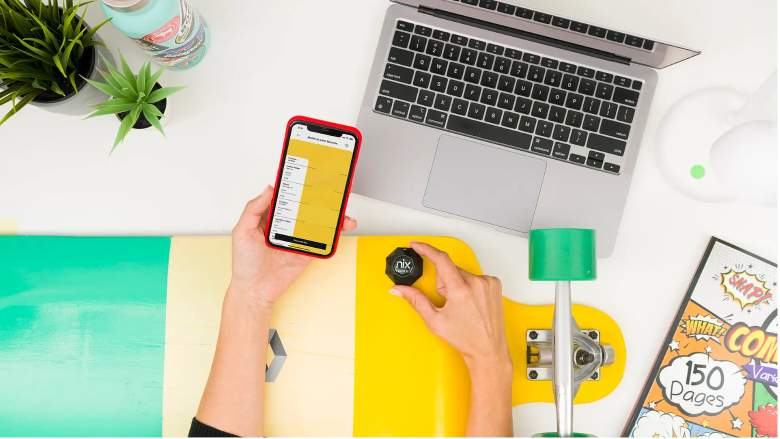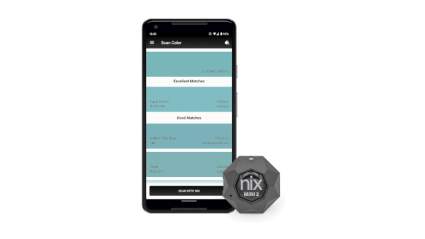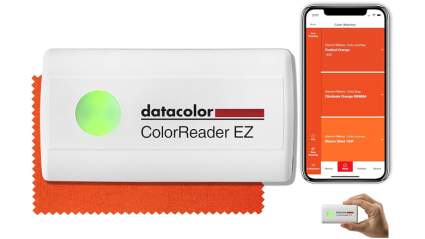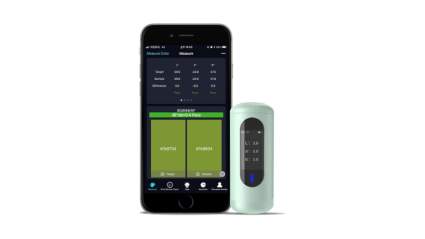
What do you do when you are getting ready to repaint parts of your house and you’ve lost track of the original paint colors you used? You either bust out the ‘ol reciprocating saw and bring pieces of each wall to the big orange store or get a digital color sensor to identify each specific shade and brand yourself. But the uses for a photoelectric colorimeter don’t stop there, which is why I’ve chosen the latter.

|
Amazon Customer Reviews
|
Price: $99.99 Shop at Amazon | Shop now Read our review |

|
Amazon Customer Reviews
|
Price: $189.68 Shop at Amazon | Shop now Read our review |

|
Amazon Customer Reviews
|
Price: $59.99 Shop at Amazon | Shop now Read our review |

|
Amazon Customer Reviews
|
Price: $99.00 Shop at Amazon | Shop now Read our review |

|
Amazon Customer Reviews
|
Price: $74.99 Shop at Amazon | Shop now Read our review |
-
1. EDITOR’S CHOICE: Color Muse 2 Colorimeter
Pros:- Color matches major brands
- Sheen measurement
- 95% color accuracy
Cons:- Poor battery life
- Doesn't read textured surfaces well
- Customer support could be better
The Color Muse 2 Colorimeter is one of the best consumer color sensors I’ve come across because it not only matches paint colors but also paint sheen to give you a more accurate understanding of which paint you’ll need. Paints come in a variety of finishes (or sheens) and most of the other color sensors I reviewed didn’t account for this when identifying paint brands.
And speaking of paint brands, the Color Muse app has just about all of the major ones in its database. This includes Sherwin-Williams, Behr, PPG, Benjamin Moore, Munsell, and on. Though you can easily reference any others that are missing online. The app also allows you to save your favorite colors for later, which is helpful when choosing new paint colors.
If you need advanced features for quality control purposes, the Color Muse Spectro 1 Pro incorporates the same great features into a professional-grade spectrophotometer with a substantially higher price tag. But even when you factor in the Color Muse 2’s lack of pro features, this colorimeter will still be the right pick for 90 percent of users.
Color Match to Products: Sherwin-Williams, Behr, PPG, Benjamin Moore, Munsell, and more
Color Comparison: HEX, CMYK, RGB, LAB, LCH, LRV, HSB, and HSV
Sheen Measurement: Yes
Light Source: Full Spectrum LEDs
Connectivity: Bluetooth LE
Dimensions: 46.8 x 46.8 x 46.3 mm
Measurement Size: 8 mm -
2. Nix Mini 2 Color Sensor
Pros:- Color matches major brands
- Shares, curates, and saves colors
- 90% color accuracy
Cons:- No sheen measurement
- Requires slow 1A charging
- Doesn't read textured surfaces well
The Nix Mini 2 Color Sensor is one of the best color sensors for DIY painters and at-home designers because of its user-friendly design and its rich suite of features. Both the photoelectric sensor itself and the free companion app (on Android and iOS) are easy to use thanks to well-documented instructions.
The Nix Mini 2 scans in color data with the push of a button and you can then use the app to find its digital color code in any of the most common formats. The app also has a massive library of paint brands and colors to reference, including Benjamin Moore, Behr, PPG, Valspar, Sherwin-Williams, and more. There is no Pantone color library but Nix has a Photoshop guide to convert a color’s CIELAB values into Pantone if needed.
The app lets you save colors you’ve recorded as well as design curated palettes around them. You can even share selections and scans with contacts at the push of a button, making it great for working with a team.
If you need professional features like making your own custom color libraries and the ability to compare two colors, you could consider the larger and pricier Nix Pro 2 Color Sensor. (It’s also one of our favorite gifts for graphic designers). If you need all that plus advanced features like spectral curve analysis and automated material quality control, then you can spring for the larger and pricier yet Nix Quality Control (QC) Color Sensor, which is the best color sensor on the consumer market.
Color Match to Products: Benjamin Moore, Behr, PPG, Valspar, Sherwin-Williams, and more
Color Comparison: sRGB, CMYK, CIELAB, HEX, LCH(ab), LRV, and Hue
Sheen Measurement: No
Light Source: 2x high-CRI, broad-spectrum LEDs
Connectivity: Bluetooth 4.0
Dimensions: 25 x 40 x 40 mm
Measurement Size: 14 mm -
3. Datacolor CRM100 ColorReader EZ
Pros:- Color matches major brands
- Shares, curates, and saves colors
- 85% color accuracy
Cons:- No sheen measurement
- Poor battery life
- Doesn't read textured surfaces well
The Datacolor CRM100 ColorReader EZ is a value-priced photoelectric colorimeter that competes with some of the major players in its market in terms of color accuracy and feature set. I wasn’t able to confirm the exact LED type that the CRM100 uses to detect the true color of a wall but it boasts an 85% accuracy rate in matching colors to the fan decks of major brands.
You get the data for all major brands including Ace, Behr, Benjamin Moore, Cloverdale, Farrow & Ball, RAL, PPG, Sherwin Williams, True Value, Valspar, and more, in the free ColorReader app available on both Android and iOS. You can also use the app to save, label, and share your favorite colors.
My favorite feature is the ability to browse digital fan decks to find coordinating colors. Just be warned that the app is very connectivity focused. You need internet access to match colors and you need the device connected to browse your saved colors. This might make things tricky if you plan to use it for remodeling work but should be easy enough to deal with for DIY remodelers.
Color Match to Products: Ace, Behr, Benjamin Moore, Cloverdale, Farrow & Ball, RAL, PPG, Sherwin Williams, True Value, Valspar, and more
Color Comparison: Delta E, L*a*b, RGB, CYMK, Hex#, LCh, and LRV
Sheen Measurement: No
Light Source: Unlisted
Connectivity: Bluetooth 4.0 LE
Dimensions: 8.2 x 4.4 x 1.5 cm
Measurement Size: 6.4 mm -
4. Ufro InstaPick Color Sensor
Pros:- Pantone-licensed matching
- Direct output to Photoshop
- High color accuracy
Cons:- No color matching to paint brands
- Limited app features
- Doesn't read textured surfaces well
The InstaPick Color Sensor is designed especially for digital artists, which makes it the best color sensor option for users who are more focused on finding color matches within digital color libraries rather than a fan deck of paint colors. More specifically, it is designed to match your color data to the Pantone library since this device is actually licensed by Pantone. That said, you can still use it to match paint colors to established brands like Behr or Sherwin-Williams by using some intermediary resource like Encycolorpedia.
The app support for the InstaPick Color Sensor is where things get complicated, though. The main app that InstaPick suggests is InstaPick also recommends a free desktop software called ColorKing+. The desktop software can send RGB and CMYK color values right into Photoshop, InDesign, or Illustrator without the need for plug-ins.
Strictly mobile users have a few free options available too but they are all pretty barebones. There is Color Judge on Android and iOS. It can interpret color in RGB and CMYK and provide the five closest Pantone reference color codes. There is also Quick Color Check on Android and iOS, a no-nonsense color-matching app that can measure the ΔE of color to determine the overall color uniformity of a surface.
While overall my top picks offer a wider range of features, the InstaPick Color Sensor is still a situationally solid choice for graphic designers looking to pluck colors from the world around them.
Color Match to Products: No
Color Comparison: RGB, CMYK, HEX, HSB, LAB, and Pantone
Sheen Measurement: No
Light Source: Unlisted
Connectivity: Bluetooth LE 5.0
Dimensions: 31.5 x 31.5 x 40 mm
Measurement Size: 12 mm -
5. Veykolor Pro Color Sensor
Pros:- Built-in display
- Long battery life
- 90% color accuracy
Cons:- No color matching to paint brands
- Doesn't read textured surfaces well
- No sheen measurement
While there isn’t anything that the Veykolor Pro does explicitly better than the competition, it is still a fairly capable color sensor that can be considered if it goes on sale or if more preferable options are out of stock. One unique aspect that I like about the Veykolor Pro is its built-in IPS display, which allows you to use the device without a smartphone.
That said, pairing this color sensor to a smartphone via Bluetooth does unlock a number of more useful features. You can use it to store data measured by the instrument to the cloud as well as create your own personal color library. The app is pretty limited on color database though, so unless you are looking for values in the Pantone coated, Pantone uncoated, or RAL K5 databases, you will need to do some extra legwork.
Granted, it is still fairly easy to take either the RGB, CMYK, HEX, HSB or LAB data and plug it into a database to find the colors yourself, you won’t even have to if you go with one of my top picks.
Color Match to Products: Color-PT Uncoat, Color-PT Coat, and RAL K5
Color Comparison: RGB, CMYK, HEX, HSB, and LAB
Sheen Measurement: No
Light Source: Full Spectrum LEDs
Connectivity: Bluetooth
Dimensions: 10.2 x 3.7 x 3.7 cm
Measurement Size: Unlisted
How Do Color Sensors Work?
Considering how modern smartphones like the iPhone 14 Pro Max have remarkably color-accurate cameras, it is understandable to imagine how identifying the true color of a surface might be fairly straightforward. But the process is not so simple. This requires an image sensor that can compensate for unwanted infrared and ultraviolet light. In other words, you need a photoelectric colorimeter rather than a camera. So how exactly do color sensors work?
Photoelectric sensors work similarly to a camera in that they capture the way light bounces off various surfaces, which we perceive as color. But this device's job is to measure color values instead of merely capturing them, which usually involves breaking down the visual light into subcomponents. Thus we end up with empirical values that can be used as reference points to find the matching brand and hue. If you want a more thorough explanation, I refer you over to Lambda Geeks for a full explanation.
What Are Color Sensors Used For?
The most popular consumer use for color sensors is to color-match paint for home renovations. And considering that homeowners are advised by experts at PaintRite Pros to repaint high-traffic portions of their homes every three to five years, you can get a lot of mileage from this handy portable gadget. But between repaintings, you may find yourself wondering what other uses this device may have.
Many of the most well-known uses for color sensors revolve around quality control of industrial goods like textiles, automotive parts, and even food. In fact, Nix makes a specialized egg yolk measurement device for this very purpose. Additionally, EE Times reports that color sensors have also been used to diagnose skin diseases in the medical field.
But for the average consumer, finding alternate uses for colorimeters requires some imagination. For example, you can use a color sensor to prove your outfit is actually different from your friends. Or you can see if teeth whitening kits actually work. But these are just ideas that I came up with. I'm certain that my readers can come up with some even more creative uses. Tweet or email me with your best ideas and I'll add them here!